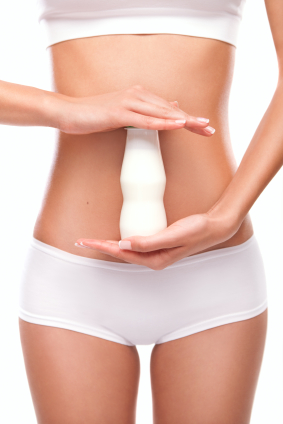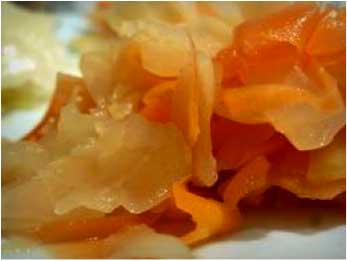Probiotics- The “Good Guys” in Our Gut
 Tuesday, July 17, 2012 at 12:30PM
Tuesday, July 17, 2012 at 12:30PM  Elisabeth Veltman, The Tender Foodie tagged
Elisabeth Veltman, The Tender Foodie tagged  What is a probiotic,
What is a probiotic,  dairy-free probiotic,
dairy-free probiotic,  fermenting your own probiotics,
fermenting your own probiotics,  raw saurkraut
raw saurkraut  Email Article
Email Article  Print Article in
Print Article in  Chef Tip,
Chef Tip,  Nutrition Tip,
Nutrition Tip,  Recipe
Recipe  Welcome to new Guest Blogger and Certified Holistic Nutrition Consultant, Brooke Kaufman. I"m super excited to have Brooke on board, her philosophy and skills will be very helpful to the Tender Foodie Community. Read more about her at the end of her article below.
Welcome to new Guest Blogger and Certified Holistic Nutrition Consultant, Brooke Kaufman. I"m super excited to have Brooke on board, her philosophy and skills will be very helpful to the Tender Foodie Community. Read more about her at the end of her article below.
Welcome Brooke!!
~Elisabeth Veltman
What is a Probiotic?
By Brooke Kaufman, Certified Holistic Nutrition Consultant
The word probiotic comes from the Latin root words – for (pro) and life (bio). Probiotics are good bacteria that live in our digestive system. For many of us, the idea that there are beneficial bacteria living inside of us sounds like an oxymoron. How can bacteria be good for us? The simple fact is that life would not be possible without these beneficial microbes. Your body contains about 100 trillion bacteria – about three pounds worth – which is more than 10 times the number of cells you have in your entire body! It's now quite clear that the type and quantity of micro-organisms in your gut interact with your body in many ways, and can either prevent or encourage the development of many diseases.
Are We "Too Clean"?
We (in the western world) have falsely come to learn that health is achieved through sanitization. We pasteurize our food, wash it with harsh chemicals, and irradiate it, then wash our hands with anti-bacterial soap before we eat. We seem to be in an eternal battle with microbes. When we begin to understand how vital they are to us, we can switch the focus from all-out war to a more balanced approach. We need to learn how to support the beneficial bacteria in our bodies, and let them do the work of keeping out the “bad guys”. It seems that the more we sterilize our lives and keep microbes out of our food and digestive systems, the less the chance that beneficial bacteria will be able to flourish, and the greater the chance that the more virulent, pathogenic types of bacteria will be able to set up shop in our gut. A simple case of not enough “good guys” to keep the “bad guys” in check is likely to develop.
The Role of Good Bacteria
Intestinal bacteria play an extremely important role in our immune system and overall health. They protect us from illness, enhance peristalsis, and manufacture many vitamins, including B-complex, folic acid and vitamin K. They also protect the integrity of the intestinal lining, help prevent the colonization of pathogens, help maintain pH balance, and aid with digestion and detoxification.
Types of Gut Loving Foods
So how do we get more beneficial bacteria in our digestive system? One of the best ways is to incorporate probiotics into our daily diets in the form of traditionally fermented foods, such as:
• Naturally fermented sauerkraut or Kimchee
• Natto (Japanese fermented soy)
• Kefir water
• Kombucha
• Miso
• Yogurt made from raw, organic milk (if you’re not lactose intolerant)
Recipe: Raw, Fermented Sauerkraut

Making raw sauerkraut is a great way to start experimenting with preparing your own fermented foods because it is super easy and affordable. Conventionally-prepared sauerkraut is cooked in brine, and does not contain the beneficial bacteria that traditionally prepared, raw sauerkraut contains. Most natural food stores sell raw sauerkraut, which is a great option, though sometimes quite pricey. Here’s a simple recipe to start you off:
Raw Sauerkraut
Ingredients
1 head green cabbage
1 Tablespoon grated fresh ginger (optional)
2 carrots, grated (optional)
1 Tablespoon sea salt
Directions
1. Grate or slice thinly the cabbage and pound with mallet to release the juices. Save the outer leaves of the cabbage and set aside.
2. Shred the carrots and add to the cabbage. Mix in the ginger and salt.
3. Place in a ceramic pot or glass container, like a large mason jar.
4. Cover the mix with the saved outer leaves of the cabbage. Place a plate on top of the leaves. Put a 4 or 5 pound weight on the plate (a brick, a bottle of sand). Cover the container with a piece of cheesecloth and then with a loose lid.
5. Leave at room temperature for 3-5 days, until desired taste is achieved. Then refrigerate.
6. When ready, remove the lid and the outer leaves and discard. Store the kraut in the refrigerator in a glass jar. It can be used immediately and will continue to ferment as it ages.
When Is It Ready?
The kraut is "ready" when it suits your taste. You can let it go longer than I've indicated above, if you like a stronger flavor. Then you discard the leaves on top, and put it an airtight jar. Refrigerating will slow, but will not completely stop the fermentation process. Sauerkraut will last a few weeks in the refrigerator.
You can put kholrabi in your sauerkraut, but you need the cabbage in as the main ingredient to get the fermentation going, since cabbage has bacteria already on it that aid in fermentation.
About Brooke
 Brooke Kaufman is a Certified Holistic Nutrition Consultant who creates customized meal plans for her clients with multiple food allergies and intolerances. She enjoys helping people eat nourishing food that is easy to prepare and tastes delicious. She believes that having food allergies and intolerances can be a positive challenge that inspires creativity, and brings a higher level of awareness when it comes to what you put in your body. Brooke believes that when we deeply nourish ourselves inside and out, we can attain optimal health…which includes healing our damaged and inflamed digestive systems.
Brooke Kaufman is a Certified Holistic Nutrition Consultant who creates customized meal plans for her clients with multiple food allergies and intolerances. She enjoys helping people eat nourishing food that is easy to prepare and tastes delicious. She believes that having food allergies and intolerances can be a positive challenge that inspires creativity, and brings a higher level of awareness when it comes to what you put in your body. Brooke believes that when we deeply nourish ourselves inside and out, we can attain optimal health…which includes healing our damaged and inflamed digestive systems.
Brooke received her nutrition education at Bauman College, and has learned through her own personal experience with food intolerances, she also works as a cleanse coach for Cleanse Organic, a 28-day, guided whole food based cleansing program.
Find her at: Balance Within Nutrition
Sources:
http://mpkb.org/home/pathogenesis/microbiota
http://www.ncbi.nlm.nih.gov/pubmed/22781886
http://www.sciencedaily.com/releases/2004/02/040202064023.htm
http://www.naturalnews.com/probiotics.html


Reader Comments (1)